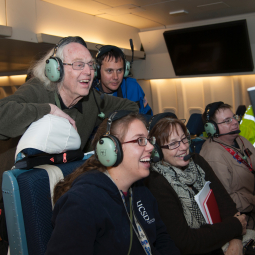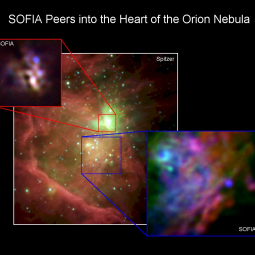The American Astronomical Society, AAS, awarded the Henry Norris Russell Lectureship to Eric Becklin, senior science advisor for SOFIA, the Stratospheric Observatory for Infrared Astronomy. The lectureship is awarded annually based on "a lifetime of eminence in astronomical research, and for his leadership role in turning infrared astronomy into a fundamental tool for understanding astronomy and astrophysics."
Becklin presented the lecture, "Fifty-four Years of Adventures in Infrared Astronomy," at the AAS' winter meeting on January 11. As SOFIA's senior science advisor, Becklin works to ensure that telescope and instrument design and operation are meeting the observatory’s goals.
"Eric Becklin has been at the forefront of infrared astronomy since the mid-1960s," said USRA President and CEO Jeffrey Isaacson. "His leadership within the infrared community has been a guiding force in the proposal and development of SOFIA and in establishing the USRA-operated SOFIA Science Center at NASA's Ames Research Center in California's Silicon Valley."
His adventures began in 1965 as a graduate student at the California Institute of Technology, when he discovered a massive star forming in the Orion Molecular Cloud, a group of bright nebulas and young stars in the Orion Constellation. This forming star can only be seen with infrared light and is now called the Becklin-Neugebauer Object.
In 1966 Becklin made the first measurements of infrared radiation from the center of our Milky Way galaxy. The radiation was later recognized as a cluster of massive stars at the center of the galaxy. He then became the first director of NASA's Infrared Telescope Facility , at Mauna Kea, Hawaii. There he led a team focused on obtaining infrared images of Jupiter to support NASA's Voyager mission . His team captured images that revealed holes in the clouds in Jupiter's atmosphere just two months before the spacecraft's second flyby of the planet in July 1979.
While at the Infrared Telescope Facility in 1988, he discovered the first L-class star, the first new stellar classification in over 80 years, which is now believed to be the first imaged brown dwarf, called GD165B. Brown dwarfs are small, cool objects that are about the same size as Jupiter, but because they generate very little energy, they do not shine with starlight. Instead they emit most of their radiation at infrared wavelengths – making them very difficult to find.
Becklin was part of an observing team that flew onboard the Kuiper Airborne Observatory , a C-141 aircraft with a 36-inch telescope, to study the circumnuclear disk at the center of the galaxy. He was also part of a team that used the mobility of that observatory to study the Sun during two solar eclipses in the 1980s. While flying inside the path of totality, they measured the height and temperature of the chromosphere, the layer 250 to 1,300 miles from the Sun's surface that gets hotter as the distance from the surface increases.
Later, Becklin became a faculty member in the department of physics and astronomy at the University of California, Los Angeles, where he helped start an infrared lab in 1989. Since then, infrared telescopes and detectors have become significantly more advanced, enabling researchers to obtain high-resolution images of objects that were previously too faint, or shrouded inside too much celestial gas and dust, to be detected.
In the 1990s he built on that advancement, leading the proposal to develop and operate SOFIA, a Boeing 747SP aircraft carrying a 100-inch (2.5-meter) telescope. Researchers have used the observatory to make the highest resolution image of the circumnuclear ring of gas and dust orbiting the black hole at the center of the Milky Way galaxy, to study celestial magnetic fields in star-forming regions, to make advance observations of New Horizons next flyby target, and more.
"It's most important to enjoy the excitement of discovery - I know I have," Becklin said during the lecture. "Thank you to all my collaborators, students, colleagues, supporters and family. The future is bright."
SOFIA is a joint project of NASA and the German Aerospace Center, DLR. NASA's Ames Research Center in California's Silicon Valley manages the SOFIA program, science and mission operations in cooperation with the Universities Space Research Association headquartered in Columbia, Maryland, and the German SOFIA Institute (DSI) at the University of Stuttgart. The aircraft is based at NASA's Armstrong Flight Research Center's Hangar 703, in Palmdale, California.


